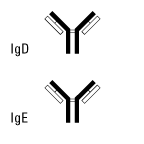Search Thermo Fisher Scientific
Immunoglobulin IgE and IgD Class
IgE and IgD are found in serum in much smaller quantities than other Ig classes. IgE primarily defends against parasitic invasion and is responsible for allergic reactions. Membrane IgD is a receptor for antigens found mostly on mature B-lymphocytes.
Properties of IgE:
- Molecular weight: 200,000
- H-chain type (MW): epsilon (73,000)
- Serum concentration: 10 to 400 ng/mL
- Percent of total immunoglobulin: 0.002%
- Glycosylation (by weight): 12%
- Distribution: basophils and mast cells in saliva and nasal secretions
- Function: protect against parasites
Properties of IgD:
- Molecular weight: 180,000
- H-chain type (MW): delta (70,000)
- Serum concentration: 0 to 0.4 mg/mL
- Percent of total immunoglobulin: 0.2%
- Glycosylation (by weight): 13%
- Distribution: lymphocyte surface
- Function: unknown

The role of IgE in the allergic response
The heavy chain of IgE contains an extra domain, by which it attaches with high affinity to Fc epsilon Receptor I (FcεRI) found primarily on eosinophils, mast cells and basophils. When antigens such as pollen, venoms, fungus, spores, dust mites or pet dander bind with the Fab portion of the IgE attached to the cells, the cells degranulate and release factors like heparin, histamine, proteolytic enzymes, leukotrienes and cytokines. As a consequence, vasodilatation and increased small vessel permeability causes fluid to escape from capillaries into the tissues, leading to the characteristic symptoms of an allergic reaction. Most of these typical allergic reactions like mucus secretion, sneezing, coughing or tear production are considered beneficial to expel remaining allergens from the body.
Studies have shown that conditions such as asthma, rhinitis, eczema, urticaria, dermatitis and some parasitic infections (e.g., helminths and tapeworms) lead to increased IgE levels. Binding of eosinophils with Fc receptors to IgE-coated parasitic helminth worms results in death of the parasite. Low levels of IgE can occur in a rare inherited disease that affects muscle coordination (ataxia-telangiectasia).
Mouse studies are important in discovering the mechanisms and treatment of allergic responses, and quantification of IgE levels is an important testing parameter.
For Research Use Only. Not for use in diagnostic procedures.